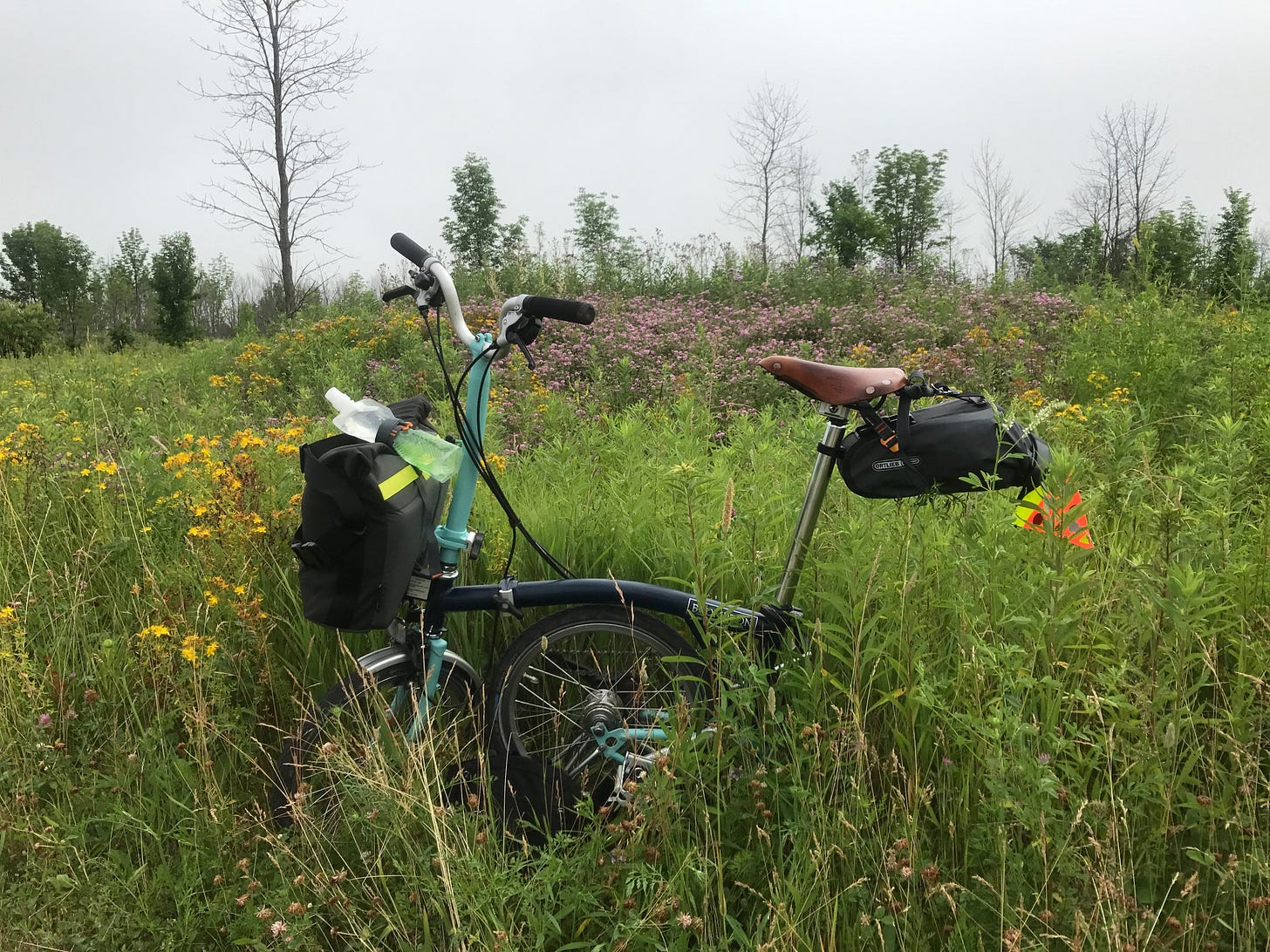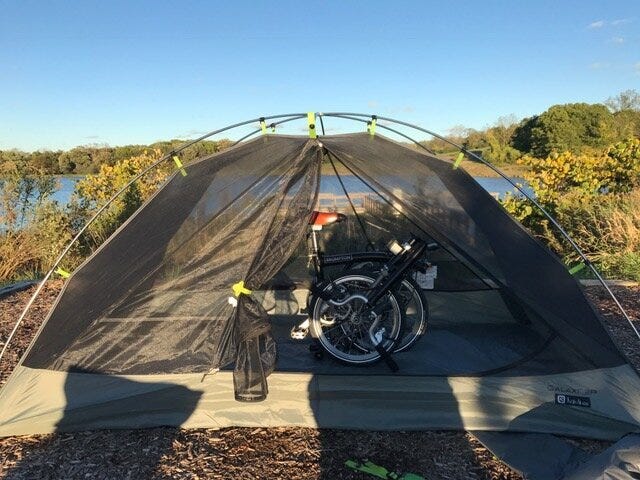For this post, I was going to include a header image from my favorite Brompton inspiration guy on Instagram. But guess what, Fellow Travelers? When I googled “brompton hammock”? My own picture ⬆️ came up #1 in Google search!
Clearly, I have hit the big-time, so here it is, in it’s full glory: Justyna’s microescape as inspiration to all those who dare to follow!
Seriously, though.
A folding bike is my hands down favorite microscope tool. It is the perfect vehicle for quick and sneaky getaways.
What is a folding bike?
It is just what it sounds like: it is a bicycle that collapses down to a small and portable package, usually by means of hinged frame that can be folded down for improved portability. Some folders use threaded connectors instead of hinges to disconnect the top and bottom frame tubes and allow the bike to be broken down for easier transporting.
Most conventional (non-folding) adult bikes have large wheels: typically 26”, 27.5” and 700c. A small handful of full-size bikes have folding capability, however the majority of folders feature smaller 20" or 16" wheels, which results in a more compact folded package.
Types of folding bikes
There are quite a few manufacturers of folding bicycles around the globe. The most familiar in the US are Dahon, Tern, Montague, Birdy, Bike Friday and —the main topic of this post— Brompton.1
Most folding bike models use a hinge or pivot point near the center of the bike, so the bike folds essentially in half.
Bike Friday, Birdy and Brompton position the break-apart points in different places on the frame. The result is a much more compact folded bicycle. But while Bike Friday is optimized for transporting in a case for long-distance travel, and can take quite a while to take apart, a Brompton folds in seconds into a compact, roughly 24”x24”x10” package that stays securely folded without a case, or any additional straps or latches.
This makes it a winner not only for urban commuting, but also for spur-of-the-moment adventures.
Why I looooove Bromptons!
Because of its quick, easy and compact folding design, a Brompton folding bike tops my list of quick getaway vehicles. It has a number of impressive advantages over most other folding bikes:
The quickest and smallest folding bike on the market (that rides like a "regular" bike)
Predictable and easy fold (10 seconds is realistic!) without the need for additional straps or tie downs to hold the pieces together
The resulting folded package is unobtrusive and welcome almost anywhere
The dirtiest parts of the bike (chain and drivetrain) are tucked inside the fold
Carefully engineered design optimized for both riding and folding
Longer unfolded wheelbase results in superior ride stability and quality
Rear suspension integrated into the design is standard on every model
Quality, time-tested components and materials
Numerous options for customization
A variety of well-made bags that integrate with the for carrying your gear
Why it’s perfect for quick getaways
In addition to being my favorite folding bicycle, Brompton is perfect for microescapes:
It can be easily stashed in your place of work for a quick and sneaky after work outings.
It doesn’t require a car rack. It easily stows in your car trunk, and can be always available for spontaneous detours or explorations.
It’s permitted on urban and suburban transit without blackout times (though it may require a cover during rush hour), so you can easily get out of town without much advance planning.
Encourages you to pack small. In fact, the Brompton is what challenged me to pack tiny, and inspired my Live Large Pack Small philosophy.
It easily fits in a tent vestibule.
It is a great ice-breaker and conversation starter when you find yourself in a new place.

Folding bike FAQ’s
Q. Aren't folding bikes slower than regular bikes, and won’t I have to pedal harder with those small wheels?
A. Wheel size is only one aspect of the bike that influences the pedaling cadence.
Your pedaling power is transferred to the wheels via the drivetrain: the chain, the front chainring, and a sprocket attached to the rear wheel. The size of the chainrings, the cogs on the sprocket and the size of the wheels all have an effect on your pedaling cadence. Bikes with smaller wheels are generally geared in a way that allows you to travel at a reasonable speed with a natural cadence.
What this means it that a quality folding bike will ride at a speed comparable to a conventional bike with normal rider effort. So, while you may not be able to keep up with a racer on a road bike, depending on your riding level, you should be able to ride comfortably in a group of riders going and a moderate to fast pace.
Q. Are those small wheels rough to ride on?
A. They can be, especially when fitted to an aluminum bike frame that many folding bike manufacturers utilize. Some folding bikes have built-in suspension to mitigate this. Bromptons have a suspension block built into the pivoting rear triangle that compresses under the rider's weight. Plus, they have steel --or steel and titanium-- frames that offer more supple ride characteristics than aluminum.
Q. Is the frame not as strong as a regular bike?
A. The hinged parts of folding bikes are reinforced and specifically designed to hold up over miles of riding. If properly unfolded and secured, the bike will not collapse under you. Keep in mind that most folding bikes are not designed for off-road use.2 However, they can be safely ridden on both paved and unpaved hard-pack surfaces, such as crushed limestone.
Q. Are folding bikes harder to maintain?
A. Not really. Folding bikes do not require more frequent maintenance than any other bike, and you can easily learn to do most of the ongoing maintenance yourself: airing the tires, oiling the chain and fixing a flat, or even replacing the brake pads.
It’s true that some folding bike components are strictly proprietary, and not easily found at your local bike shop. However, those parts are not the ones that require regular maintenance. And some non-proprietary parts —for example high quality smaller tires— can be a little harder to find. Even when using standard parts, folding bikes have some idiosyncratic requirements specific to their design, so for that reason, it’s probably best to have any major services performed by an authorized dealer.
Q. I heard folding bikes are expensive. Are they a good value?
A. Quality folding bikes, including Bromptons, typically run $1800-2200 (with some premium models even in the range of $3000-$5500). Because they are well-made, and because the manufacturer has a strong history of quality control, solid customer service and a dependable dealer network, you know you will be able to get ongoing support. The bikes are easy to live with, designed for convenience, and so versatile that you may end up using one in more ways than you anticipated, so your investment will definitely pay off.
Q. But they're so hard to lock. How will I keep it from getting stolen?
A. The best thing about folding bikes, and especially one as easily and quickly folding as a Brompton, is they NEVER have to be locked outside. Simply fold it, and carry or roll it in with you wherever you go. You'll find that you can bring it in without any problems into stores, restaurants, offices, and onto buses, trains and car-share vehicles.
Where to go?
In addition to the microadventure pictured at the top of this post, here is a handful of examples of some quick day trips and mini-vacations I took on a Brompton.
Brompton & Trail 24-Hour Mini Tour: A car-free mini-tour using a combination of urban and suburban transit, hotel, and over 50 miles of dedicated bike trails.
Solo Brompton Camping Overnight: An overnight camping trip to Bullfrog Lake, part of Cook County Forest Preserves in Illinois.
Milwaukee Meander: A day tour of Milwaukee using the town's extensive bike trail network (and visiting lovely open-air beer gardens!)
Cannon Valley Ride: An example of seizing an unexpected opportunity on the way back from from a trip to Minneapolis.
What these outings all share is a sense of spontaneity, minimal packing and planning, and being open to chance adventures. I hope you use them as a starting point for devising your own microescapes.
But first, you’ll need a Brompton!
As always, we look forward to seeing you.
—Justyna
PS. Fellow travelers, this is a reminder that our labor prices will be going up in March. So come on down, and get your bike worked on now: you’ll save money and avoid the three-week backlog, which can literally sneak up on us in a single weekend!
It should be noted that there’s an exploding category of electric folding bikes. However my emphasis here on non-motorized activities. Many of the less expensive folding electric bikes are shockingly heavy (68-70lbs), which runs counter to the "live large, pack small" ideal, and —frankly— defeats the purpose of having folding bike in the first place. Notable lighter weight exceptions are GoCycle and Brompton, both of which come in at well under 40lbs.
The exciting new development is Brompton G-Line (the “G” stands for “gravel”), which —though a bit bigger than the classic Brompton— is optimized for use on unpaved roads. Available this spring by pre-order only!






